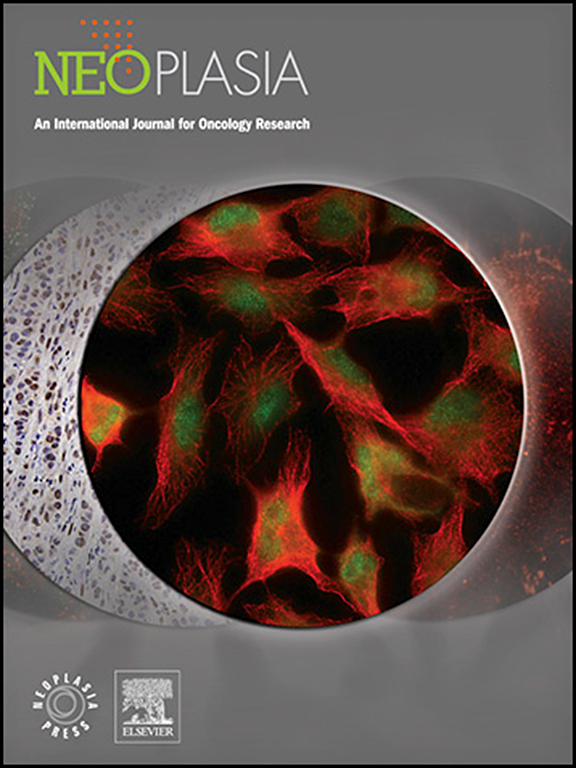XAF1由应激肿瘤细胞分泌,通过Lck-ERK信号激活T细胞介导的肿瘤监测
IF 4.8
2区 医学
Q1 Biochemistry, Genetics and Molecular Biology
引用次数: 0
摘要
凋亡相关因子1 x连锁抑制剂(XAF1)是一种应激诱导的肿瘤抑制因子,在多种类型的人类恶性肿瘤中通常失活。然而,xaf1介导的肿瘤抑制的分子基础在很大程度上仍未明确。在这里,我们报道了XAF1在各种细胞毒性应激条件下由细胞分泌,并激活T细胞介导的肿瘤监测。在暴露于干扰素- γ、肿瘤坏死因子- α和依托oposide的癌细胞中,XAF1通过非常规的内溶酶体运输途径被升高并积极分泌,XAF1的锌指4结构域在这种分泌中起着至关重要的作用。分泌的XAF1通过网格蛋白介导的内吞作用内化到附近的T细胞中,刺激T细胞的增殖、迁移和肿瘤浸润。内化的XAF1通过与淋巴细胞特异性蛋白酪氨酸激酶的直接相互作用和磷酸化激活RAF-MEK-ERK信号。注射干扰素γ后,Xaf1+/+肿瘤的消退率和T细胞浸润率明显高于Xaf1 - / -肿瘤,而注射重组Xaf1后,Xaf1 - / -肿瘤的T细胞浸润率明显降低。在T细胞富集的癌症患者中,XAF1表达与总生存率相关,也与基于T细胞的免疫疗法的预后相关。总之,我们的研究确定了XAF1是一种新的分泌性免疫调节肿瘤抑制因子,阐明了其失活在肿瘤发生中的机制后果。本文章由计算机程序翻译,如有差异,请以英文原文为准。
XAF1 is secreted from stressed tumor cells to activate T cell-mediated tumor surveillance via Lck-ERK signaling
X-linked inhibitor of apoptosis-associated factor 1 (XAF1) is a stress-inducible tumor suppressor that is commonly inactivated in multiple types of human malignancies. Nevertheless, the molecular basis for the XAF1-mediated tumor suppression remains largely undefined. Here, we report that XAF1 is secreted from cells under various cytotoxic stress conditions and activates T cell-mediated tumor surveillance. In cancer cells exposed to interferon , tumor necrosis factor , and etoposide, XAF1 is elevated and actively secreted through the unconventional endo-lysosomal trafficking pathway and the zinc finger 4 domain of XAF1 plays an essential for this secretion. Secreted XAF1 is internalized into nearby T cells through clathrin-mediated endocytosis and stimulates proliferation, migration, and tumor infiltration of T cells. Internalized XAF1 activates RAF-MEK-ERK signaling through the direct interaction with and phosphorylation of lymphocyte-specific protein tyrosine kinase. In response to interferon injection, Xaf1+/+ tumors display significantly higher regression rate and T cell infiltration compared to Xaf1−/− tumors while Xaf1−/− tumors are markedly reduced by injection of recombinant Xaf1. XAF1 expression is associated with overall survival in T cell-enriched cancer patients and also correlates with prognosis in T cell-based immunotherapies. Together, our study identifies XAF1 as a novel secretory immune-modulatory tumor suppressor, illuminating the mechanistic consequence of its inactivation in tumorigenesis.
求助全文
通过发布文献求助,成功后即可免费获取论文全文。
去求助
来源期刊

Neoplasia
医学-肿瘤学
CiteScore
9.20
自引率
2.10%
发文量
82
审稿时长
26 days
期刊介绍:
Neoplasia publishes the results of novel investigations in all areas of oncology research. The title Neoplasia was chosen to convey the journal’s breadth, which encompasses the traditional disciplines of cancer research as well as emerging fields and interdisciplinary investigations. Neoplasia is interested in studies describing new molecular and genetic findings relating to the neoplastic phenotype and in laboratory and clinical studies demonstrating creative applications of advances in the basic sciences to risk assessment, prognostic indications, detection, diagnosis, and treatment. In addition to regular Research Reports, Neoplasia also publishes Reviews and Meeting Reports. Neoplasia is committed to ensuring a thorough, fair, and rapid review and publication schedule to further its mission of serving both the scientific and clinical communities by disseminating important data and ideas in cancer research.
 求助内容:
求助内容: 应助结果提醒方式:
应助结果提醒方式:


